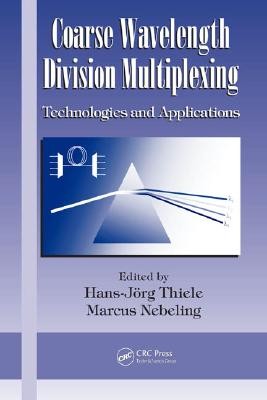| Coarse Wavelength Division Multiplexing: Technologies and Applications Contributor(s): Nebeling, Marcus (Editor), Thiele, Hans Joerg (Editor) |
|
 |
ISBN: 0849335337 ISBN-13: 9780849335334 Publisher: CRC Press OUR PRICE: $209.00 Product Type: Hardcover Published: June 2007 Annotation: Explaining what CWDM is, how it is achieved, and why it should be deployed, Coarse Wavelength Division Multiplexing: Technologies and Applications merges coverage of isolated aspects of Coarse Wavelength Division Multiplexing (CWDM) traditionally found as device-related or specific system topics. Emphasizing cost savings and performance enhancement, the book integrates information on component issues, system architectures, concepts for extensions and upgrades, as well as practical applications into a comprehensive, single-volume resource. Beginning with a summary of the ITU-T standards defining CWDM, the book addresses the three essential component classes, optical fibers, transceivers, and WDM filters, which combine to form the basis for the CWDM transmission link. The following chapters include coverage of different architectures such as hubbed rings and meshed networks, and upgrade paths to overcome limitations of current CWDM systems. The book outlines the feasibility of optically amplified CWDM systems, investigates the challenges present with high-speed CWDM and bidirectional transmission, and finally elucidates the importance of CWDM for a wide range of applications. Each chapter provides sufficient information to be used independently and contains references to relevant papers and articles for further study. The last sections of the book focus on applications and case studies where CWDM plays an ever-increasing role. They include extensive studies on networking, reach extension by amplification, and the latest concepts of transmission capacity upgrades using increased bit-rates or new channel plans. Filled with practical information, the book provides a clearunderstanding of recent developments in the dynamic field of CWDM. |
| Additional Information |
| BISAC Categories: - Technology & Engineering | Fiber Optics - Technology & Engineering | Telecommunications - Technology & Engineering | Electrical |
| Dewey: 621.382 |
| LCCN: 2006101008 |
| Series: Optical Science and Engineering |
| Physical Information: 0.98" H x 6.28" W x 8.99" (1.36 lbs) 376 pages |
| Descriptions, Reviews, Etc. |
| Publisher Description: Explaining what CWDM is, how it is achieved, and why it should be deployed, Coarse Wavelength Division Multiplexing: Technologies and Applications merges coverage of isolated aspects of Coarse Wavelength Division Multiplexing (CWDM) traditionally found as device-related or specific system topics. Emphasizing cost savings and performance enhancement, the book integrates information on component issues, system architectures, concepts for extensions and upgrades, as well as practical applications into a comprehensive, single-volume resource. Beginning with a summary of the ITU-T standards defining CWDM, the book addresses the three essential component classes, optical fibers, transceivers, and WDM filters, which combine to form the basis for the CWDM transmission link. The following chapters include coverage of different architectures such as hubbed rings and meshed networks, and upgrade paths to overcome limitations of current CWDM systems. The book outlines the feasibility of optically amplified CWDM systems, investigates the challenges present with high-speed CWDM and bidirectional transmission, and finally elucidates the importance of CWDM for a wide range of applications. Each chapter provides sufficient information to be used independently and contains references to relevant papers and articles for further study. The last sections of the book focus on applications and case studies where CWDM plays an ever-increasing role. They include extensive studies on networking, reach extension by amplification, and the latest concepts of transmission capacity upgrades using increased bit-rates or new channel plans. Filled with practical information, the book provides a clear understanding of recent developments in the dynamic field of CWDM. |